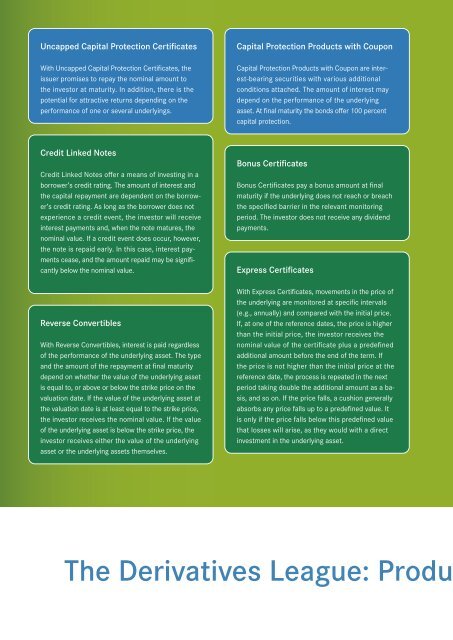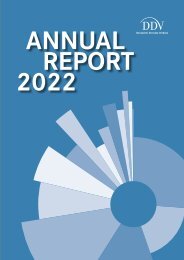DDV Annual Report 2021
You also want an ePaper? Increase the reach of your titles
YUMPU automatically turns print PDFs into web optimized ePapers that Google loves.
Uncapped Capital Protection Certificates<br />
With Uncapped Capital Protection Certificates, the<br />
issuer promises to repay the nominal amount to<br />
the investor at maturity. In addition, there is the<br />
potential for attractive returns depending on the<br />
performance of one or several underlyings.<br />
Credit Linked Notes<br />
Credit Linked Notes offer a means of investing in a<br />
borrower’s credit rating. The amount of interest and<br />
the capital repayment are dependent on the borrower’s<br />
credit rating. As long as the borrower does not<br />
experience a credit event, the investor will receive<br />
interest payments and, when the note matures, the<br />
nominal value. If a credit event does occur, however,<br />
the note is repaid early. In this case, interest payments<br />
cease, and the amount repaid may be significantly<br />
below the nominal value.<br />
Reverse Convertibles<br />
With Reverse Convertibles, interest is paid regardless<br />
of the performance of the underlying asset. The type<br />
and the amount of the repayment at final maturity<br />
depend on whether the value of the underlying asset<br />
is equal to, or above or below the strike price on the<br />
valuation date. If the value of the underlying asset at<br />
the valuation date is at least equal to the strike price,<br />
the investor receives the nominal value. If the value<br />
of the underlying asset is below the strike price, the<br />
investor receives either the value of the underlying<br />
asset or the underlying assets themselves.<br />
Capital Protection Products with Coupon<br />
Capital Protection Products with Coupon are interest-bearing<br />
securities with various additional<br />
conditions attached. The amount of interest may<br />
depend on the performance of the underlying<br />
asset. At final maturity the bonds offer 100 percent<br />
capital protection.<br />
Bonus Certificates<br />
Bonus Certificates pay a bonus amount at final<br />
maturity if the underlying does not reach or breach<br />
the specified barrier in the relevant monitoring<br />
period. The investor does not receive any dividend<br />
payments.<br />
Express Certificates<br />
With Express Certificates, movements in the price of<br />
the underlying are monitored at specific intervals<br />
(e.g., annually) and compared with the initial price.<br />
If, at one of the reference dates, the price is higher<br />
than the initial price, the investor receives the<br />
nominal value of the certificate plus a predefined<br />
additional amount before the end of the term. If<br />
the price is not higher than the initial price at the<br />
reference date, the process is repeated in the next<br />
period taking double the additional amount as a basis,<br />
and so on. If the price falls, a cushion generally<br />
absorbs any price falls up to a predefined value. It<br />
is only if the price falls below this predefined value<br />
that losses will arise, as they would with a direct<br />
investment in the underlying asset.<br />
Discount Certificates<br />
Discount Certificates give a discount on the current<br />
price of the underlying. This discount provides a<br />
cushion against potential falls in the price of the<br />
underlying. In return, investors accept a cap on<br />
profits from potential price rises, and they do not<br />
receive any dividends.<br />
Tracker Certificates<br />
Tracker Certificates offer exposure to the movements<br />
in the price of an underlying instrument. This means<br />
that with just one certificate, investors can put their<br />
money into an asset class, sector or region, optimising<br />
and diversifying their portfolio.<br />
Constant Leverage Certificates<br />
Constant Leverage Certificates provide leveraged<br />
exposure to both rising (long) and falling (short)<br />
prices of a reference value. They generally have<br />
no fixed term and are based on a reference value<br />
whose daily percentage change is reflected using a<br />
constant factor. The size of the factor determines<br />
the leverage with which the Constant Leverage Certificate<br />
tracks the daily percentage price change of<br />
the reference value. In principle, the constant factor<br />
can be represented by a formula or a factor index.<br />
Total loss of the invested capital is possible, especially<br />
if the reference value is subject to strong fluctuations.<br />
Outperformance / Capped<br />
Outperformance Certificates<br />
With Outperformance Certificates, if the price of<br />
the underlying asset goes up, investors receive a<br />
return equal to a pre-specified multiple of the return<br />
on the underlying asset. Capped Outperformance<br />
Certificates offer investors the opportunity for leveraged<br />
profit from a rise in the price of the underlying<br />
above the strike price within a specified range. The<br />
profit is limited by a cap. With products of this type,<br />
the investor’s exposure to potential losses below the<br />
strike price is limited to any loss in the underlying.<br />
There is no entitlement to a dividend.<br />
Warrants<br />
Warrants provide leveraged exposure to rising (call)<br />
and falling (put) prices in an underlying. The price is<br />
influenced not only by movements in the underlying,<br />
but also by other factors such as volatility or the<br />
(residual) term. If the price of the underlying at maturity<br />
is below (call) or above (put) the strike price,<br />
investors lose their entire capital.<br />
Knock-Out Warrants<br />
Like Warrants, Knock-Out Warrants also provide<br />
leveraged exposure to rising (call) and falling (put)<br />
prices in an underlying. Knock-out Warrants track<br />
the movements of the underlying on a one-to-one<br />
basis. This largely eliminates the impact of volatility.<br />
If the knock-out barrier is breached, investors generally<br />
lose all their invested capital.<br />
The Derivatives League: Product classification of the








